
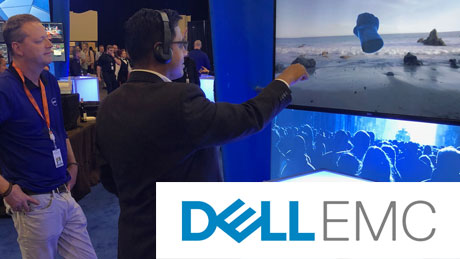 2018 - Seattle, Washington: Dell came back to our team to build a new application. They wanted something new. Something different. Some way to stand out from everyone else. Virtual Reality was becoming more common, so it wasn't exciting enough to their customers. They wanted innovation. So, I thought long and hard about it and invented a new method for interacting with 360 videos using just your hands. I used a Leap Motion hardware device to track hand gestures and positions, and used that as the interface device for interacting with 360 videos. Using just your hands, you can turn your view and look around.
2018 - Seattle, Washington: Dell came back to our team to build a new application. They wanted something new. Something different. Some way to stand out from everyone else. Virtual Reality was becoming more common, so it wasn't exciting enough to their customers. They wanted innovation. So, I thought long and hard about it and invented a new method for interacting with 360 videos using just your hands. I used a Leap Motion hardware device to track hand gestures and positions, and used that as the interface device for interacting with 360 videos. Using just your hands, you can turn your view and look around.
We had three distinct scenes, so I decided to make each one have an interesting interactive element. On the ocean cleanup scene, you begin by helping to pick up virtual trash from a beach and then you learn about Dell's ocean plastics cleanup and recycling program. On another scene, you reach out and splice DNA together, and then learn about how Dell is using powerful computing to do genomic research. In the final scene, you get to learn about solar powered computer classrooms in third world countries. I got to see the exhibit at the Dell World convention in Las Vegas and see how users reacted to my new application. It was the first of its kind in the world, and people were taking cell phone videos of the interaction. But, what about user engagement? Were people just infatuated with the novelty, or was the underlying messages getting across to users? I watched a 20 something year old german guy go through and watch every single corporate video, which was about 15 minutes of media content. Had it been presented in any other format, I doubt most people would not have had the interest or patience.
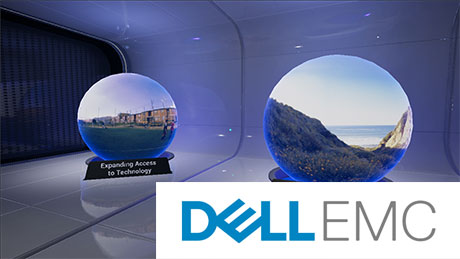 2017 - Seattle, Washington: I work in a coworking space with a lot of local film makers. I am interested in bringing the film industry and game industries closer together, and I see the point of intersection happening in virtual reality. I have joined forces from time to time with them to complete immersive virtual reality video projects for corporate clients. Dell contacted us and wanted our help in producing an application which showed off their philanthropic programs to help make the world a better place, under the #LegacyOfGood tag. Leaning on my game development experience, I created a virtual reality application for the Android Samsung S6,S7, & S8 phones. This was a hybrid between virtual reality and immeresive 360 video, which nobody has done before. It's worth mentioning that during the event, a die hard VR fan had passionate feelings against 360 video in VR, but after he tried out my application, his mind was radically changed.
2017 - Seattle, Washington: I work in a coworking space with a lot of local film makers. I am interested in bringing the film industry and game industries closer together, and I see the point of intersection happening in virtual reality. I have joined forces from time to time with them to complete immersive virtual reality video projects for corporate clients. Dell contacted us and wanted our help in producing an application which showed off their philanthropic programs to help make the world a better place, under the #LegacyOfGood tag. Leaning on my game development experience, I created a virtual reality application for the Android Samsung S6,S7, & S8 phones. This was a hybrid between virtual reality and immeresive 360 video, which nobody has done before. It's worth mentioning that during the event, a die hard VR fan had passionate feelings against 360 video in VR, but after he tried out my application, his mind was radically changed.
2012 - US Army Division HQ, Baghram, Afghanistan:When troops are near the end of their tour, they are required to go through a mess of paperwork and training (safety briefs, suicide prevention, acclimating to civilian life, etc). It can be a confusing mess for the average soldier to track and manage. I wanted to create a simple, straight forward, streamlined system which simplified it so that every soldier could do their own outprocessing without assistance. I created a centralized system which brought all of the training media and classes to one location, verified their completion, tied it to user profiles, and walked people through each form they needed to fill out, step by step. It was so streamlined, that I had an army staff sergeant come to our office and say, "I've been on seven tours, and this was the easiest post deployment training I've ever done."
2012 - US Army Division HQ, Baghram, Afghanistan: In 2012, I went to work in Bagram, Afghanistan as a senior developer to build enterprise level applications for the US Army Headquarters. I built a tool which allowed ground teams to submit quarterly evaluations on developmental progress on a per district basis, based on economic activity, local governance, local security, and overall impressions. This helped us figure out where we were winning and losing the war at a district level and allocate resources and attention accordingly. Once a district was determined to be consistently stable, its management would be turned over to the Afghan National Army and Afghan Governments. We were able to observe trends by comparing quarterly reports over time to see if our actions were having a measurable effect on outcomes.
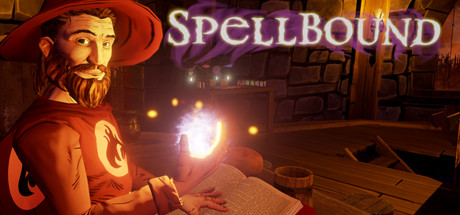 2015 - Seattle, Washington: Spellbound is a virtual reality game where you play as a wizard and you use your own hands to throw fireballs at zombies. I completed the first section of the game and released in commercially on Steam in Early Access. I still continue working on this project. I am currently working on creating a machine learning artificial intelligence system which uses reinforcement learning on a dynamically generated graph using markovian decision processes. This is extremely challenging and would probably be the first of its kind in the world. The end objective is to have thousands of different AI agents, all with different behavior options and personality traits, decide what the most optimal behavior is for their given situation, and then gradually learn more optimal behaviors over time through experimentation and evolutionary strategies. Further research and development is required, but it could have far reaching applications beyond just video games. Unlike current machine learning algorithms which require robust training sets, my AI system would learn and adapt in the wild.
2015 - Seattle, Washington: Spellbound is a virtual reality game where you play as a wizard and you use your own hands to throw fireballs at zombies. I completed the first section of the game and released in commercially on Steam in Early Access. I still continue working on this project. I am currently working on creating a machine learning artificial intelligence system which uses reinforcement learning on a dynamically generated graph using markovian decision processes. This is extremely challenging and would probably be the first of its kind in the world. The end objective is to have thousands of different AI agents, all with different behavior options and personality traits, decide what the most optimal behavior is for their given situation, and then gradually learn more optimal behaviors over time through experimentation and evolutionary strategies. Further research and development is required, but it could have far reaching applications beyond just video games. Unlike current machine learning algorithms which require robust training sets, my AI system would learn and adapt in the wild.
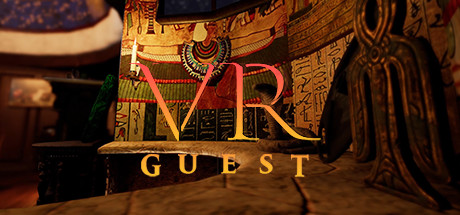 2018 - Seattle, Washington: Chronos Global Academy had been commissioned to deliver a virtual reality game for a client on the Gear VR mobile platform. They had a major optimization problem: the application would cause the Samsung S6 phone to overheat within five minutes. This was blocking them from commercially releasing the product. We were commissioned to optimize the application to hit performance targets, add support for the Oculus Rift & Touch hardware platforms, and troubleshoot deployment and launch issues. We successfully launched the game on Oculus Store for Gear VR, Oculus Rift, and Oculus Go, as well as launching on Steam for the HTC Vive.
2018 - Seattle, Washington: Chronos Global Academy had been commissioned to deliver a virtual reality game for a client on the Gear VR mobile platform. They had a major optimization problem: the application would cause the Samsung S6 phone to overheat within five minutes. This was blocking them from commercially releasing the product. We were commissioned to optimize the application to hit performance targets, add support for the Oculus Rift & Touch hardware platforms, and troubleshoot deployment and launch issues. We successfully launched the game on Oculus Store for Gear VR, Oculus Rift, and Oculus Go, as well as launching on Steam for the HTC Vive.
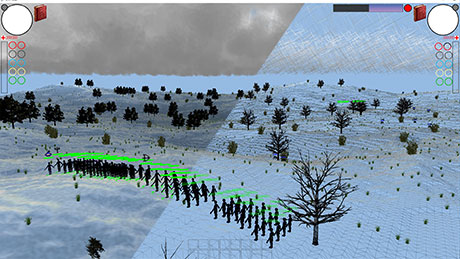 2013 - Seattle, Washington: I decided to start my own game company to make realtime 3D games. I spent 12 months writing my own 3D game engine from scratch, using C# and XNA. It is extremely difficult to make real time games in 3D. Most of the game engine features were built to support an existing game design I had come up with. I had a dynamically generated landscape system with automated levels of detail, instanced static meshes, artificial intelligence, particle systems, and graphical user interface support. I knew it was a mistake to build my own engine, but I thought it would be a faster prototyping tool than existing game engines. Finally, I needed to add a feature which would take two weeks to implement, or two minutes to read API documentation in an existing engine. I cut the project and switched to Unreal Engine 4, which had recently been released. The great thing about Unreal Engine 4 is that all of the source code is available to see and modify, so if I ever had a question about how the engine works or needed it to have a new capability, I could just modify existing source code.
2013 - Seattle, Washington: I decided to start my own game company to make realtime 3D games. I spent 12 months writing my own 3D game engine from scratch, using C# and XNA. It is extremely difficult to make real time games in 3D. Most of the game engine features were built to support an existing game design I had come up with. I had a dynamically generated landscape system with automated levels of detail, instanced static meshes, artificial intelligence, particle systems, and graphical user interface support. I knew it was a mistake to build my own engine, but I thought it would be a faster prototyping tool than existing game engines. Finally, I needed to add a feature which would take two weeks to implement, or two minutes to read API documentation in an existing engine. I cut the project and switched to Unreal Engine 4, which had recently been released. The great thing about Unreal Engine 4 is that all of the source code is available to see and modify, so if I ever had a question about how the engine works or needed it to have a new capability, I could just modify existing source code.
2012 - US Army Division HQ, Baghram, Afghanistan: The security staff section came to me with a problem: They had to issue tests to thousands of people at a time and they were overwhelmed by grading, issuing certificates, and giving classes. They had five people working around the clock, grading exams and issuing certificates to those who passed. They were so overwhelmed that they could not see to the other duties and functions of their office. I decided that the best solution would be to create a silverlight application which gave the necessary training via video clips and narrated powerpoint slides, and then issued a timed test at the end. The test would grade itself at the very end and then generate a certificate. At the same time, their successful completion of the test would be logged into the backend system, so that other staff sections could verify completion with a rapid name lookup. Thousands of people went through my training system and got training certificates. The Staff Security Office was ecstatic because I relieved them of hundreds of weekly man hours, allowing them to focus on other important mission objectives. Not only did they not need to hire on additional staff, they could do more with the same staff on hand.
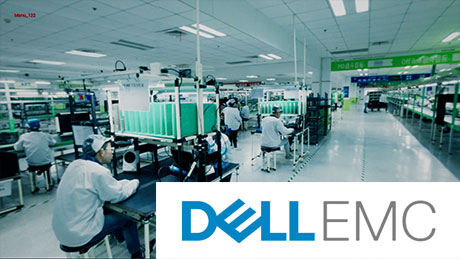 2017 - Seattle, Washington: Dell/EMC builds and assembles computers in their factories located in China. They want to be transparent with the world about their production processes, their sustainable business practices, and working conditions for their factory employees. In the past, Dell would give in-person tours of their factory to VIPs who wanted to see the production pipeline. It was generally expensive, took a lot of time, and the factory tours were physically limited. Dell asked us to help build a virtual reality tour of their factory floor as a way to be transparent with the world about their ethical business practices. Initially, the VR tour was going to be for internal use only, but it was so well produced that they decided to go public with it and they regularly show it off to the public at events around the world. We are happy to continue building our relationship with Dell.
2017 - Seattle, Washington: Dell/EMC builds and assembles computers in their factories located in China. They want to be transparent with the world about their production processes, their sustainable business practices, and working conditions for their factory employees. In the past, Dell would give in-person tours of their factory to VIPs who wanted to see the production pipeline. It was generally expensive, took a lot of time, and the factory tours were physically limited. Dell asked us to help build a virtual reality tour of their factory floor as a way to be transparent with the world about their ethical business practices. Initially, the VR tour was going to be for internal use only, but it was so well produced that they decided to go public with it and they regularly show it off to the public at events around the world. We are happy to continue building our relationship with Dell.
2012 - US Army Division HQ, Baghram, Afghanistan: The ISR tool was built for the intelligence community. It was used to track the effectiveness of various drones, aircraft, balloons, etc. Details are classified.
2004 - Camp Fallujah, Iraq: After the initial ground invasion of Iraq (OIF 1) by Multi-National Forces (MNF), I joined the civil affairs group in Fallujah, Iraq in early 2004. I liked the humanitarian focused mission. I was tasked with being a web developer to help the nation rebuild their civil infrastructure. At the time, contracts were being writen and funded very quickly, but there was little tracking of what was being done, where, and by whom. It was my job to build an enterprise wide system to track and manage contracts and to share that information across the region. Multiple institutions would be users: US Army Corps of Engineers (USACE), Navy Construction Battalion (Seabees), Marine Corps Engineers, etc. The reconstruction projects were focused on bringing clean drinking water to every city, providing reliable electricity 24 hours a day, proper sewage treatment, transportation, civil infrastructure, etc. Despite working out of tents and getting shot at on a daily basis, I accomplished the mission in three months. I presented it to the commanding general (James Conway) and he was excited by the visibility it gave him. He made it an official program of record. By the end of my seven month tour, I had $1.1 billion dollars worth of contracts tracked and managed by my system, being jointly used by all branches of service.
2004 - US Embassy, Baghdad, Iraq: Following the success of ICMOP, I was invited out to the U.S. Embassy in Baghdad to produce a similar application for the national logistics team. They needed a system to track the logistical shipments of goods coming into the country from various points of entry, across various modes of transport, and needed to know where those goods were located, the value of the goods, the type of the goods, etc. I used my existing project as a template for building the new nation wide supply chain management system and had it operational within a month. By the end of my tour, this system was tracking $1 billion of goods coming into country and provided high level visibility to command staff.
As you can see from our track record of past projects, we have a history of delivering unique, innovative solutions tailored to meet customer needs. Let's work together to learn how we can work together to build something useful and valuable.